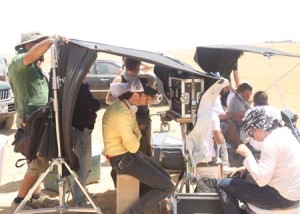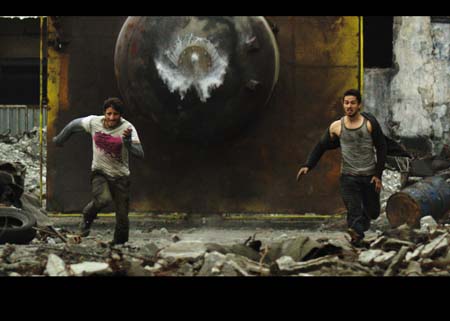City of Life Director Ali Mostafa, who recently wrapped up the filming and post production work on his second film, From A to B, speaks exclusively to Vibhuti Arora about his latest project Ali Mostafas debut feature film, City of Life, not only won him recognition as a director and filmmaker but also drew attention […]

City of Life Director Ali Mostafa, who recently wrapped up the filming and post production work on his second film, From A to B, speaks exclusively to Vibhuti Arora about his latest project
Ali Mostafas debut feature film, City of Life, not only won him recognition as a director and filmmaker but also drew attention to Dubai as a creative centre. When Mostafa decided to make another film, he thought of drawing attention to Abu Dhabi, the UAE’s capital city.
His latest film is a travelogue entitled From A to B, where A refers to Abu Dhabi and B stands for Beirut. From A to B is about three childhood friends on a road trip from Abu Dhabi to Beirut, passing through Saudi Arabia, Jordan and Syria. Each country offers a different landscape and culture and a different set of people that the trio encounters, and the film portrays these interactions.
From A to B began with a story idea, as all films do. Mostafa had already made a drama and this time around, he wanted to experiment with another genre. He chose comedy for his second project.
When he took the idea of a travelogue to twofour54s CEO, Noura Al Kaabi, she was quick to offer support. Twofour54 is the commercial arm of the Media Zone Authority Abu Dhabi, that facilitates the development of Arabic media and entertainment content in the region.
While twofour54 offered infrastructural and post production assistance, another Abu Dhabi film entity, Image Nation, got involved as executive producers and agreed to fund the film.
“It was the first time that two Abu Dhabi entities were joining forces to work on a project. Whats more, I was given complete creative freedom on the project and there was no restraint, whatsoever, from these studios,” Mostafa comments.
“I got a lot of support from Image Nation’s Michael Garin, Mohammed Al Mubarak, Ben Ross and fellow director Majid Al Ansari, who now works with Image Nation.
“We shot most of the film in Abu Dhabi and shot some parts in Beirut and Jordan as well. With the situation in Syria, we obviously couldnt shoot there and I did not see the need to shoot in Saudi Arabia either. The shots showing Syria were filmed in Jordan and we created a set to show the Saudi border,” informs Mostafa.
Besides the three main leads, a Range Rover Evoque plays key role in the film. The protagonists use the same car throughout the film and it is quite interesting to see what the car undergoes in the process.
“We have termed this genre a dramedy as it has generous doses of comedy as well as drama. Being a travelogue, it has a sprinkling of adventure as well. We have been careful to capture the cultural nuances and the dialects of each region, as the film travels from Abu Dhabi to Beirut,” comments Mostafa.
Each of the three protagonists comes from a different country, though they all went to the same American school in the UAE. The film has a fair degree of Western influence. In fact, at least 30% of the films dialogue is in English, with the rest in Arabic.
It was critical that the film have the right cast, which posed a challenge initially. The three main leads in the film are played by Shadi Alfons, Fadi Rifaai and Fahad Albutairi.
“It wasnt easy to cast. When I was developing the script, I knew who I wanted but dont have any of those leads in the film now. As the story evolved, the actors that I had planned to cast in the beginning did not suit the roles anymore. So we began to audition in Egypt and Saudi Arabia.
“In the end everything fitted together like the pieces in a jigsaw. All three protagonists are first-time actors but I think that worked to our advantage and each of them delivered exceptional performances. While they are well-known in their respective fields, none of them is a film actor,” Mostafa says.
YouTube phenomenon Fahad Albutairi plays the Saudi lead. At first glance doesnt come across as someone to play a Westernised Saudi youngster, but according to the director no one could have done it better.
“When auditioning in Egypt, one person who really stood out in the auditions happened to be a writer on the Dr Bassem Youssef show. He too has a big following in Egypt. Our third lead was finalised just three days before we were scheduled to begin shooting. The three of them had perfect chemistry, which comes across on the screen,” comments Mostafa.
The film also has cameos by popular actors from the Arab film industry, further adding to its pan-Arab appeal.
Filming and post production
The main challenges came in the initial stages of development and in finding the right team.
“Filmmaking is very expensive in this part of the world because a handful of companies enjoy monopolies here. We rented all of our equipment from Gamma Engineering ,who offered us good rates. It also helped to work with a DoP Michel Dierickx with whom my association goes back 11 years. We have worked together on many commercials. He also worked on camera B in City of Life and was the main DoP on this film. We are used to working with Alexa cameras and used the ARRI Alexa XT for this particular project. It shoots in RAW so we expected outstanding image quality,” says Mostafa.
From A To B
was shot in 3K using ARRI Alexa XT camera. Canon C500 was also on hand to shoot scenes inside the car, if required.
“Certain stunts that we could do only once, we tried to cover using a Canon C500. For a crash scene, however, as many as six cameras were called in, ranging from the ARRI Alexa XT to Canon C500 to the GoPro. We managed to cover as much as possible on Alexa XT because a lot of the scenes were shot on a low loader, a trailer that you put the car on and stick the camera out to rig.”
Twofour54 intaj gave post production support for the film. The editing was done using Avid solutions at the twofour54 facility in Abu Dhabi.
“We shot From A to B over 29 days and finished its post production in seven weeks. Now we are in the final stages of editing the film and need to fine tune it a bit,” says the director.
Twofour54s in-house editor, Ali Suloom, edited the film and gave the director a rough cut as soon as filming was over. The film is expected to be released before the end of 2014, the director says.
“For us the best time to launch the film would be at the Abu Dhabi Film Festival in October but nothing is set in stone,” he informs.
City of Life and From A to B
Unlike From A to B, City of Life was an independent film for which the director had personally raised the money, and there was no studio overseeing the project. The making of From A To B was also quite different from City of Life, which was a bigger film and required more production support.
“We would have seven to eight trucks convoyed by police while shooting City of Life, such was the scale of that production. From A To B did not need that kind of setup, because it belonged to a different genre altogether,” Mostafa says.
An experience to cherish
As for its production highlights, the director points out that the entire film was like an adventure as he is quite fascinated by road trips in real life too.
“We were on a set in Jordan where we had to shoot the characters meeting some individuals. The scene involved at least 24 setups that had to be completed in four hours. There was no way we could have pulled that through, so we decided to call our steadicam operator back from the hotel and did the entire scene in one shot.”
For Mostafa, the experience of shooting in Petra in Wadi Rum in Jordan was something to cherish. While scouting for locations, he was guided by the same scout who helped Steven Spielberg and Michael Bay with location hunting for their films.
“I have always looked up to these filmmakers as legends and having the opportunity to film in the same locations meant a lot to me. Theres a train scene in our film that used the same train and was shot at the same location that was used in Lawrence of Arabia.
“Lawrence of Arabia is one of the most inspirational films I have watched and I have a huge amount of admiration for David Lean, its director,” Mostafa says.
Mostafa says his style of filmmaking is still evolving. For him, films are a medium to tell stories in an entertaining way and should have mass appeal.
“Although I love making stories for people, I also write films that I believe have commercial value. I dont want to make films that are purely artistic or cater to a niche audience. I want my films to have universal appeal and reach out to as many people across the world as possible.
“Filmmaking is an organic process, one needs to improvise while filming for best creative results,” comments Mostafa.
Although a lot changed for Mostafa as a filmmaker after City of Life, it still took him four years to make another film, which goes to show how difficult it is to make movies in this part of the world.
“This also goes to show how young our industry is. We have a lot of Emirati filmmakers but the industry is still nascent. We need films to make an industry, which is lacking as of now. Theres a long way to go for us but the future seems bright.”
As Mostafa points out, at least four Emirati feature films have been produced this year alone, which has never happened before.










































































